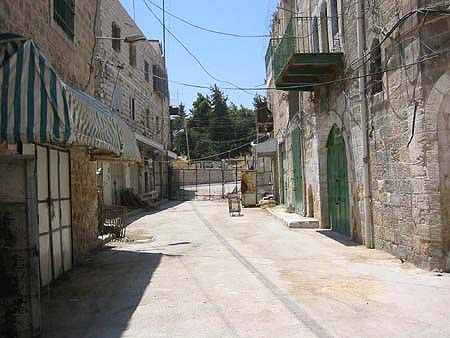 Many thanks to the reader who reminded us that "Hebron" is the Jewish name for the city in the West Bank; the Arabic name is al-Khalil.
Many thanks to the reader who reminded us that "Hebron" is the Jewish name for the city in the West Bank; the Arabic name is al-Khalil.
---
Christopher Hayes writes for The Nation:
The first thing you notice when you drive into Hebron is the lack of cars. Since 1997 this second-largest Palestinian city in the West Bank, the only one with an Israeli settlement in its midst, has been formally divided. Within the Israeli section, which takes up much of the historic downtown, Palestinians are not allowed to drive, so they walk or use donkey carts. When people are ill or injured, they are carried to the hospital. It is not surprising, therefore, that many of the 30,000 Palestinians who once lived here have moved out. According to a 2007 report from Israeli human rights organizations, more than 1,000 Palestinian housing units in the area have been left vacant, and more than 75 percent of the businesses in the central district have closed. A handful of shops remain open; a cluster or two of children play in the street. But that's it. The streets are buried under the heaviness of an ominous quiet. Periodically, buses rumble past bringing settlers to and from the adjoining settlement, Kiryat Arba, and Israel proper. In the absence of routine urban noise, their engines sound like gunshots....
in 1997, as part of the Oslo peace process, security control over Hebron was divided. Palestinian Hebron, now home to some 170,000, fell under the jurisdiction of the Palestinian Authority and became known as H1. The section dominated by Israeli settlers remained under IDF [Israel Defense Forces] control and became known as H2. There are 800 Israeli citizens who live in H2, with 500 IDF soldiers to guard them.
Within its jurisdiction, the IDF enforces a policy it calls "separation," which has a renewed urgency in the wake of the second intifada. A three-foot concrete barrier runs down the main street of the downtown, creating a small shoulder where Palestinians may walk; Israelis pass on the other side. A few blocks farther on, an Israeli soldier and a flag on a rooftop herald the beginning of the zone the army calls "fully sterilized," meaning no Palestinians. A young merchant hawking bracelets followed our group, entreating us to buy a souvenir. He stopped short, as if running into a glass wall, the moment we hit the outpost.
It felt as if we were walking through a postapocalyptic urban video game brought to life. The old Hebron gold market sat empty and trashed, every shop door was shuttered, graffiti was scrawled over much of the area. Eight Israeli soldiers with flak jackets and machine guns marched slowly past in formation, making their regular patrol through the deserted streets. A police car began to tail us, since Mikhael has been assaulted by settlers while leading people through the neighborhood.
In the courtyard outside the main settlers' apartment complex, a group of boys played soccer in a lot sandwiched between a large recycling bin half full of plastic bottles and a sign that read, in part: This land was stolen by arabs following the murder of 67 hebron jews in 1929. We demand justice! Return our property to us! Women in head wraps and long skirts pushed strollers; men walked past with shopping bags. Though they live inside a heavily militarized garrison, they can walk the empty streets as if in a European pedestrian mall.
Around the corner, on Shuhada Street, are the last Palestinian holdouts in the neighborhood. They occupy second-floor apartments with balconies covered in metal braces and chicken wire. Because the street is closed to Palestinians, the residents of these caged apartments are not allowed to use their front doors; at those rare times when they leave to get provisions they must go out via the roof or makeshift doors.